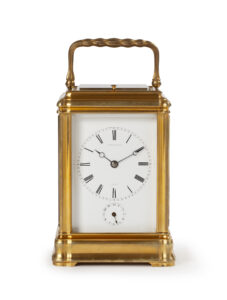TRAVELLING CLOCK WITH STRIKING Breguet No. 1643 Ca. 1910 France
M&R111
TRAVELLING CLOCK
Signed and numbered: Breguet No. 1643
Circa 1910
France
Movement
The spring-driven brass movement consists of going and striking trains. The going train has Swiss lever escapement with adjustable ‘Breguet’ hairspring balance. The striking indicates the hours and the half hours on a gong. From backside the clock is also wound and the time can be set. The maker has signed and numbered the movement as follows: Breguet No. 1643
Dial
The movement has a circular engine-turned silver dial with a Roman chapter ring, five-minute and minute divisions. The time is indicated by a pair of blued steel hands named after the maker: Breguet hands. The dial is signed and numbered by the maker in the middle: Breguet 1643. The dial is protected by a convex glass set in a cast and chased gilt brass bezel.
Case
The case, which rests on four gilt brass bun-like feet is veneered with burr Amboina. The back panel can be slid up, a construction typical of Breguet, to access the movement.
Duration: 1 week
Height: 18 cm.
Width: 13.5 cm.
Depth: 10 cm.
Literature
– Tardy, Dictionnaire des Horlogers Français, pp. 84 t/m 97.
– George Daniels, The Art of Breguet, p. 198.
– H.M. Vehmeyer, Antieke uurwerken, een familieverzameling, p. 600
– Charles Allix, Carriage Clocks, p. 40 Plate II/4.
The maker
Abraham-Louis Breguet was born in Neuchâtel (Switzerland) in 1747. From 1762-1767 he was trained to be a watchmaker, probably in Versailles with Lépine and/or Berthoud. In 1768 he emigrated together with his parents and sisters to Paris. In the evenings he studied mathematics at the Collège Mazarin. In 1775 he married Cécile-Marie-Louise L’Huillier (born in 1752). In the same year the couple opened a shop on the Quai d’Horloge 51, now No. 79, near Pont Neuf, right in the middle of the clockmakers quarter. This can be called the year of the foundation of Maison Breguet. Breguet formed an association with Xavier Gide, a watch dealer in Paris, in 1787 which lasted until 1791. On 12 August 1793 Breguet and his wife and son Louis-Antoine fled to Switzerland, for fear of the revolution, first to Genève, then to Neuchâtel and finally to Le Locle. Op 10 April 1795 they returned to Paris and went to live at the former address on the Quai d’Horloge in 1796. The following years until his death in 1823 were the most fruitful of his career. In 1807 his son Antoine joined the company. He had followed part of his education with John Arnold in London. Breguet invented several novelties in watch making, such as the Breguet winding key (which cannot be turned the wrong way), various improvements to the watch escapement, the ‘montre perpétuelle (self-winding watch), the tourbillon, the ‘pendule sympathique’, the ‘montres à tact’, also called the ‘montre aveugle’ and the ‘heures sautantes’ (jumping hours). He died in Paris on 17 September 1823.














